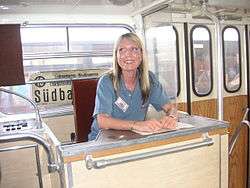Bus conductor

Bus conductors (also referred to as conductors, or clippers), were a common feature of many local bus services in larger towns and cities in the UK and Ireland, until the late 1970's and early 1980's. The main reason two-person crews were needed was that most towns and cities used double-decker buses for urban services. Until the 1960s, all double deck vehicles were built with front-mounted engines and a "half-cab" design, like the familiar Routemaster London bus. This layout totally separated the driver from the passenger saloons. The conductor communicated with the driver using a series of bell codes, such as two bells to start (the well-known "ding-ding").
Many half-cab double-deckers were boarded from an open platform at the rear, while others were equipped with a forward entrance and staircase and driver-operated doors. Each case required a conductor to collect fares and, especially on the rear-entrance design, supervise passenger loading and unloading. Some bus services in the late 1960s and early 1970s experimented with later-model forward entrance half-cab double-deckers—removing the conductor and having the driver sell tickets, as on the rear entrance buses that were common by that time. The hope was to have the benefits of one-person operation without the cost of replacing vehicles that still remaining service life. This idea was soon scrapped and the buses reverted to conventional conductor operation.
Demise of the conductor
In the late 1950s, new double-decker bus designs appeared that provided higher capacity, with the engine compartment at the rear and the entrance by the driver. From July 1966, UK transport regulations were changed to allow operation of urban double-deck buses by the driver only, who could now collect fares and supervise all passenger loading and unloading.
Some municipal operators adopted rear-engine bus designs and "one-person operation" quickly, others more slowly. More conservative municipal operators continued to order new half-cab buses through the 1960s, but this type of vehicle ceased production in the UK by about 1970. This was accelerated by a UK Government grant that supported the purchase of "one person operated" vehicles, but was not available for purchase of traditional half-cab buses.
Through the 1970s, the proportion of urban bus routes operated with conductors declined, as older vehicles were steadily replaced with new buses equipped for one-person operation, and operators grappled with staff shortages, rapidly increasing costs and falling ridership.
Exceptions
Britain and Ireland
By the early 1980s bus conductors were largely obsolete in all cities except London and Dublin. London was a special case. Two-person crews continued to operate a number of bus routes in central London until late 2005, well beyond their demise in the rest of the country. This reprieve for conductors was due to continued use of the famous Routemaster bus.
The Routemaster was purpose-built for London conditions and remained well suited to the busiest routes in the most congested parts of central London. This was because of its maneuverability, fast passenger loading/unloading capability, and fare collection by the conductor instead of the driver. The Routemaster construction was of high quality, the design robust, and mechanical and body parts could be easily rebuilt and refurbished. Importantly, the "traditional red bus" is also a unique tourism icon for London, instantly recognisable around the world.
Though the majority of bus services in the London metropolis (and all routes outside the central area) have been operated by modern driver-only vehicles since the late 1980s, 20 regular routes retained Routemasters and conductors in 2003. Between 2003 and 2005, each of these has been progressively converted to modern vehicles and one-person-operation. The process was largely driven by political views on disability-accessibility, and assisted to some extent by the increase in litigious passengers claiming injuries due to the Routemaster's open rear platform. There were also increasingly frequent robberies and attacks on conductors, who could find themselves working in an isolated and vulnerable environment. The last "regular" (as opposed to tourist-oriented) Routemaster-operated service was the 159 from Marble Arch to Streatham. Conductor operation finally ceased on the 159 on 9 December 2005.
A revival in conductor operation on buses in the UK has occurred with the development of the ftr routes in York, Leeds and Swansea. Stagecoach Strathtay still uses conductors on service 73(A) from Arbroath, Carnoustie and Monifieth to Ninewells Hospital. Quantock Motor Services, Somerset, operates the service 400 'Exmoor Explorer' using crew-operated vintage open top buses. The conductors also returned to London in 2012 with the introduction of the New Routemaster. Some of the routes served by the New Routemaster will not have conductors so the service will be driver only operation controlling three doors of the bus. The role of the conductor is to ensure passengers validate their Oyster card as they board on the bus and supervise passengers using the open platform.[1]
India and Pakistan
In India and Pakistan, bus conductors are almost always present inside the buses throughout the journey. Government bus conductors may communicate with the driver via a bell, whistle, or by shouting, "right!" (Aa right in south India). Private bus conductors use whistles or just shout to the driver. Also its quite common practice for conductors to clap their hand firmly on the outside of the bus as a signal to the driver that all passengers have boarded and the bus is good to go.
References
- ↑ "Role of the conductor for the New Routemaster". Retrieved 14 June 2014.